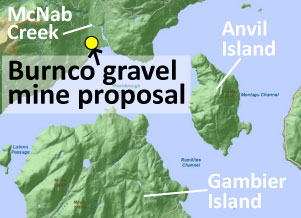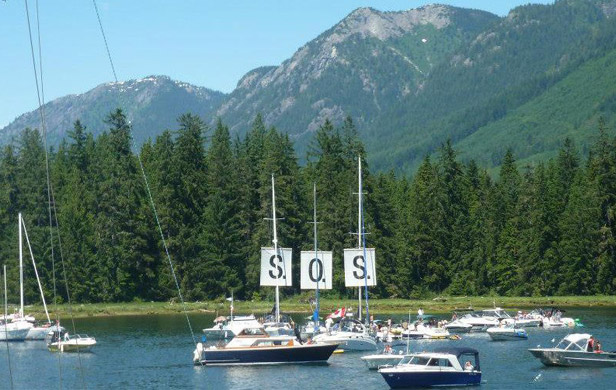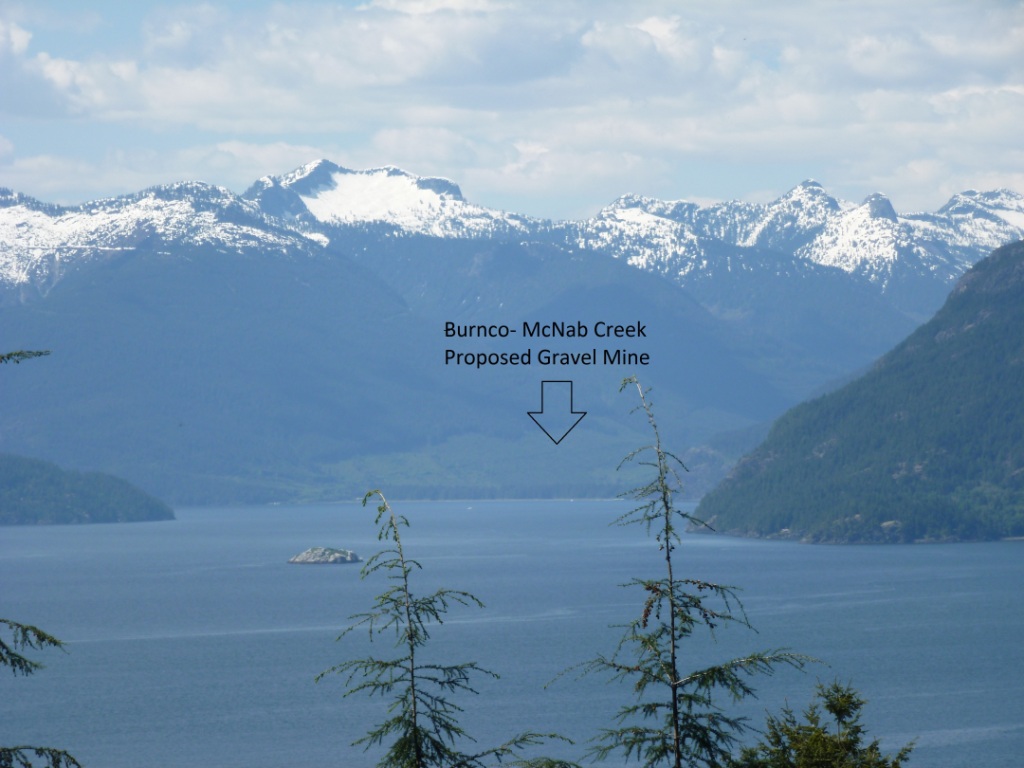
Public can send comments about proposed mine on the shores of Howe Sound to Environmental Assessment Office until November 27
By Margot Grant
Following years of opposition to the proposed Burnco gravel pit on McNab Creek, the provincial environment ministry will make its decision after the period for public comments ends on November 27.
Approval is also required from the federal government. After Minister of the Environment Catherine McKenna receives a report by the Canadian Environmental Assessment Agency on the project in early December, the public will have a chance to comment for 30-45 days.
“It’s important the new NDP and Liberal ministers know this project has no social license,” the Future of Howe Sound Society says on its website.
Burnco Rock Products wants to extract 20 million tonnes of sand and gravel from McNab Creek over a period of 16 years. The pit would create a 30-hectare lake with a depth of up to 35 metres, and an additional 47 hectares would be taken up by facilities for rock crushing, processing, sorting and storage. The product would be shipped to the Fraser River Burnco site from a dock designed for two large barges, one of which would leave every other day, year-round. Burnco says it plans to run the plant five or six days a week during daylight hours. The project would provide 12 full-time jobs.

Opponents of the mine point to the destruction of the McNab Valley, an undisturbed nature area, and note that McNab Creek is an important fish-bearing area. Both the Future of Howe Sound Society and the Sunshine Coast Conservation Association have voiced concern over the threat to fish habitat.
“Even the whales are part of that food chain,” Ruth Simons, executive director of the society, told The Coast Clarion.
Simons is sceptical about the production amount and extraction period in Burnco’s application. “We have seen this elsewhere in B.C.: a company gets environmental approval for a certain quantity and period, but no new assessment is needed for an extension. We know the project started off much larger and we heard from the owners that they want to extract as much as possible.”
Simons is a leader in the campaign to have Howe Sound declared a UNESCO Biosphere Reserve. The Howe Sound Biosphere Region Initiative has been formally registered as an organization, allowing the group to apply for grants and funding.
The town of Gibsons, the districts of West Vancouver and Squamish, the village of Lions Bay, the island municipality of Bowen Island, and the Squamish, Lillooet and Sunshine Coast regional districts have all endorsed the initiative. MLAs Nicholas Simons (Powell River-Sunshine Coast — NDP) and Jordan Sturdy (West Vancouver-Sea-to-Sky — Liberal) also support the project.
Approval of the Burnco gravel pit could be a setback for the Howe Sound initiative. “McNab Valley is such a beautiful area,” Simons said. “It would be a terrible loss.”

Burnco produces and sells a broad range of agggregate products in British Columbia, Alberta and the United States. It calls itself “leading stewards of the environment in our industry.“ According to Integrity BC, it has donated a total of $180,700 to the BC Liberal Party during the past few years.
“Demand locally for aggregate is strong right now,” Derek Holmes, Burnco Rock Products land and resource manager for British Columbia, wrote in an email to The Coast Clarion. “As long as current economic conditions continue to drive demand, Burnco plans to begin construction as soon as the project is fully permitted. [The] project will benefit the local economy, our company and the construction needs of the Lower Mainland.”
“I heard many people say during the review that a comprehensive management plan for Howe Sound is needed to properly balance a variety of commercial, industrial and recreational needs within this multi-jurisdictional area. Burnco supports this fully,” Holmes wrote. “The results of this thorough [environmental] assessment show that the project can proceed with no adverse environmental impacts, and I think that the ministers will see this too.
“Protestors talk about no social license quite loosely, but in fact the environmental assessment process is exactly the opposite. We’ve spent countless hours modifying key project designs to limit nuisance and provide added social benefit to the community. The transparency of the process does not hide any of these details,” Holmes wrote.
Submissions to the Environmental Assessment Office can be made online until November 27.
We must be missing something about the “added social benefit to the community”. If it is transparent where is it and what is it?
The project does not have the ongoing approval within the local community or with many other stakeholders according to the public comments submitted over the past 7 years this assessment has been in progress. There never has been approval or broad, ongoing social acceptance except perhaps with those who stand to gain financially. Burnco intends to replace existing supply it currently purchases from other viable sources on the coast with its own supply at McNab. There are no guarantees or conditions on where it ends up or how any savings are passed on to consumers.
To date Burnco has not communicated any “benefits” to the local community that we “protestors” are aware of, nor have they taken any supportive actions in the local community. We are aware of a cash offer to the Squamish Streamkeepers in exchange for their “support” of their new fish compensation channel and we are aware of the vague offer of hydro power to the McNab Strata properties that stand to lose the most, but so far we see the scales tipped over in favor of Burnco at the local community’s expense. Devaluing property values, disrupting peace and quiet, the estuary, the wildlife, increasing vessel traffic and threatening the recovery of Howe Sound can never be offset by enough financial incentives for those who care about the future of Howe Sound.